Élisabeth Vigée Le Brun
| Élisabeth Louise Vigée Le Brun | |
|---|---|
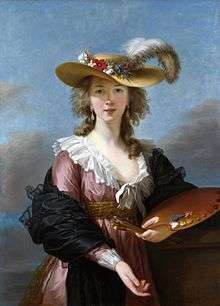 Self-Portrait with Straw Hat, 1782 | |
| Born |
Élisabeth Louise Vigée 16 April 1755 Paris, France |
| Died |
30 March 1842 (aged 86) Paris, France |
| Nationality | French |
| Known for | Painting |
| Movement | Rococo, Neoclassicism |
Élisabeth Louise Vigée Le Brun (16 April 1755 – 30 March 1842),[1] also known as Madame Lebrun or Madame Le Brun, was a prominent French portrait painter of the late eighteenth century.
Her artistic style is generally considered part of the aftermath of Rococo with elements of an adopted Neoclassical style.[2] Her subject matter and color palette can be classified as Rococo, but her style is aligned with the emergence of Neoclassicism. Vigée Le Brun created a name for herself in Ancien Régime society by serving as the portrait painter to Marie Antoinette. She enjoyed the patronage of European aristocrats, actors, and writers, and was elected to art academies in ten cities.[3]
Vigée Le Brun created some 660 portraits and 200 landscapes.[4] In addition to many works in private collections, her paintings are owned by major museums, such as the Louvre, Hermitage Museum, National Gallery in London, Metropolitan Museum of Art in New York, and many other collections in continental Europe and the United States.
Biography
.jpg)
Early life
Born in Paris on 16 April 1755, Élisabeth Louise Vigée was the daughter of a portraitist and fan painter, Louis Vigée, from whom she received her first instruction.[1] Her mother, Jeanne (née Maissin) (1728–1800), was a hairdresser.[1] In 1760, at the age of five, she entered a convent, where she remained until 1766.[1] Her father died when she was twelve years old. In 1768, her mother married a wealthy jeweler, Jacques-François Le Sèvre, and shortly after, the family moved to the Rue Saint-Honoré, close to the Palais Royal.[5] In her memoir, Vigée Le Brun directly stated her feelings about her step-father: "I hated this man; even more so since he made use of my father's personal possessions. He wore his clothes, just as they were, without altering them to fit his figure."[6] During this period, Élisabeth benefited from the advice of Gabriel François Doyen, Jean-Baptiste Greuze, and Joseph Vernet, whose influence is evident in her portrait of her younger brother, Étienne Vigée (1773).[5]
By the time she was in her early teens, Élisabeth was painting portraits professionally.[7] After her studio was seized for her practicing without a license, she applied to the Académie de Saint-Luc, which unwittingly exhibited her works in their Salon. In 1774, she was made a member of the Académie.[7] On 11 January 1776 she married Jean-Baptiste-Pierre Le Brun, a painter and art dealer. Vigée Le Brun began exhibiting her work at their home in Paris, the Hôtel de Lubert, and the Salons she held here supplied her with many new and important contacts.[7] Her husband's great-great-uncle was Charles Le Brun, the first director of the French Academy under Louis XIV. Vigée Le Brun painted portraits of many of the nobility.
On 12 February 1780, Vigée-Le Brun gave birth to a daughter, Jeanne Julie Louise, whom she called Julie and nicknamed "Brunette."[6]
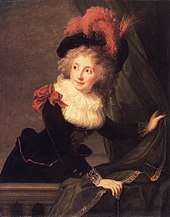
In 1781 she and her husband toured Flanders and the Netherlands, where seeing the works of the Flemish masters inspired her to try new techniques. Her Self-Portrait with Straw Hat (1782) was a "free imitation" of Peter Paul Rubens' La Chapeau de Paille (ca. 1622-25).[8][9] Dutch and Flemish influences have also been noted in The Comte d'Espagnac (1786) and Madame Perregaux (1789).[10]
In 1787, she caused a minor public scandal when her Self-Portrait with Her Daughter Julie (1787) was exhibited at the Salon of 1787 showing her smiling and open-mouthed, which was in direct contravention of traditional painting conventions going back to antiquity. The court gossip-sheet Mémoires secrets commented: "An affectation which artists, art-lovers and persons of taste have been united in condemning, and which finds no precedent among the Ancients, is that in smiling, [Madame Vigée LeBrun] shows her teeth."[11] In light of this and her other Self-Portrait with Her Daughter Julie (1789), Simone de Beauvoir dismissed Vigée Le Brun as narcissistic in The Second Sex (1949): "Madame Vigée-Lebrun never wearied of putting her smiling maternity on her canvases."[12]
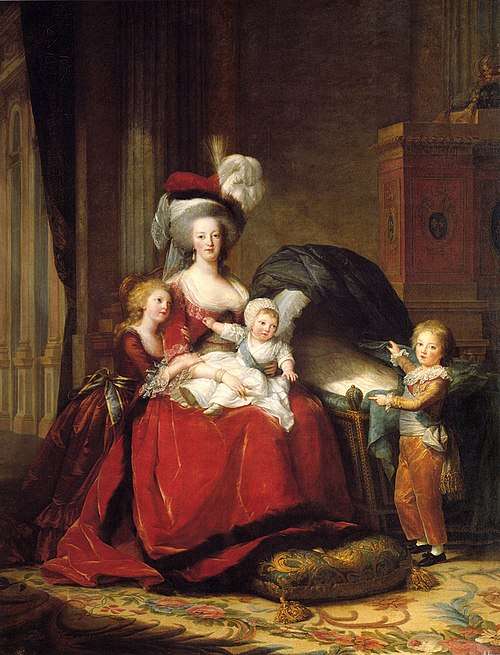
Marie Antoinette
As her career blossomed, Vigée Le Brun was granted patronage by Marie Antoinette.[7] She painted more than thirty portraits of the queen and her family,[7] leading to the common perception that she was the official portraitist of Marie Antoinette. At the Salon of 1783, Vigée Le Brun exhibited Marie-Antoinette in a Muslin Dress (1783), sometimes called Marie-Antoinette en gaulle, in which the queen chose to be shown in a simple, informal white cotton garment.[13] The resulting scandal was prompted by both the informality and the queen's decision to be shown in that way.[13] Vigée Le Brun's later Marie-Antoinette and her Children (1787) was evidently an attempt to improve the queen's image by making her more relatable to the public, in the hopes of countering the bad press and negative judgements that the queen had recently received.[14] The portrait shows the queen at home in the Palace of Versailles, engaged in her official function as the mother of the king's children, but also suggests Marie-Antoinette's uneasy identity as a foreign-born queen whose maternal role was her only true function under Salic law.[15]

Académie royale de peinture et de sculpture
On 31 May 1783, Vigée Le Brun was received as a member of the Académie royale de peinture et de sculpture.[16] She was one of only fifteen women to be granted full membership in the Académie between 1648 and 1793.[16] Her rival, Adélaïde Labille-Guiard, was admitted on the same day.[17] Vigée Le Brun was initially refused on the grounds that her husband was an art dealer, but eventually the Académie was overruled by an order from Louis XVI because Marie Antoinette put considerable pressure on her husband on behalf of her portraitist.[18] As her reception piece, Vigée Le Brun submitted an allegorical painting, Peace Bringing Back Abundance (La Paix qui ramène l'Abondance), instead of a portrait.[18] As a consequence, the Académie did not place her work within a standard category of painting—either history or portraiture.[18] Vigée Le Brun's membership in the Académie dissolved after the French Revolution because female academicians were abolished.[2]
Exile
In October 1789, after the arrest of the royal family during the French Revolution, Vigée Le Brun fled France with her young daughter, Julie.[19] Her husband, who remained in Paris, claimed that Vigée Le Brun went to Italy "to instruct and improve herself",[18] but she certainly feared for her own safety.[20][6][19] In her twelve-year absence from France, she lived and worked in Italy (1789-92), Austria (1792-95), Russia (1795-1801), and Germany (1801).[20]
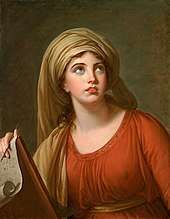
Italy
While in Italy, Vigée Le Brun was elected to the Academy in Parma (1789) and the Accademia di San Luca in Rome (1790).[20] In Naples, she painted portraits of Maria Carolina of Austria (sister of Marie Antoinette) and her eldest four living children: Maria Teresa, Francesco, Luisa, and Maria Cristina.[20] She later recalled that Luisa "was extremely ugly, and pulled such faces that I was most reluctant to finish her portrait."[6] Vigée Le Brun also painted allegorical portraits of the notorious Emma Hamilton as Ariadne (1790) and as a Bacchante (ca. 1792). Lady Hamilton was similarly the model for Vigée Le Brun's Sibyl (1792), which was inspired by the painted sibyls of Domenichino.[18][21] The painting represents the Cumaean Sibyl, as indicated by the Greek inscription on the figure's scroll, which is taken from Virgil's fourth Eclogue.[22] The Sibyl was Vigée Le Brun's favorite painting.[20] It is mentioned in her memoir more than any other work.[20][18] She displayed it while in Venice (1792), Vienna (1792), Dresden (1794), and Saint Petersburg (1795); she also sent it to be shown at the Salon of 1798.[6][21] Like her reception piece, Peace Bringing Back Abundance (1783), Vigée Le Brun regarded her Sibyl as a history painting, the most elevated category in the Académie's hierarchy.[22]
_Le_Brun.jpg)
Austria
While in Vienna, Vigée Le Brun was commissioned to paint Princess Maria Josefa Hermengilde von Esterhazy as Ariadne (1793) and its pendant Princess Karoline von Liechtenstein as Iris (1793).[23] The portraits depict the Liechtenstein sisters-in-law in unornamented Roman-inspired garments that show the influence of Neoclassicism, and which may have been a reference to the virtuous republican Roman matron Cornelia, mother of the Gracchi.[23]
Russia

In Russia, where she stayed from 1795 until 1801, she was received by the nobility and painted numerous aristocrats, including the last king of Poland, Stanisław August Poniatowski, and members of the family of Catherine the Great.[24] Although the French aesthetic was widely admired in Russia,[25] there remained various cultural differences as to what was deemed acceptable. Catherine was not initially happy with Vigée Le Brun's portrait of her granddaughters, Elena and Alexandra Pavlovna, due to the amount of bare skin the short-sleeved gowns revealed.[6] In order to please the Empress, Vigée Le Brun added sleeves. This tactic seemed effective in pleasing Catherine, as she agreed to sit herself for Vigée Le Brun (although Catherine died of a stroke before this work was due to begin).[19] While in Russia, Vigée Le Brun was made a member of the Academy of Fine Arts of Saint Petersburg.[7] Much to Vigée Le Brun's dismay, her daughter Julie married Gaétan Bernard Nigris, secretary to the Director of the Imperial Theaters of Saint Petersburg.[20]
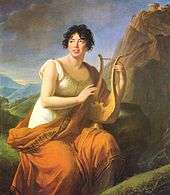
Return to France and later life
After a sustained campaign by her ex-husband and other family members to have her name removed from the list of counter-revolutionary émigrés, Vigée Le Brun was finally able to return to France in January 1802.[1] She travelled to London in 1803, to Switzerland in 1807, and to Switzerland again in 1808.[1] In Geneva, she was made an honorary member of the Société pour l'Avancement des Beaux-Arts. She stayed at Coppet with Madame de Staël, who appears as the title character in Corinne, ou l'Italie (1807).[5]
In her later years, Vigée Le Brun purchased a house in Louveciennes, Île-de-France, and divided her time between Louveciennes and Paris. She died in Paris on 30 March 1842, aged 86. She was buried at the Cimetière de Louveciennes near her old home. Her tombstone epitaph says "Ici, enfin, je repose..." (Here, at last, I rest...).
Between 1835 and 1837, when Vigée Le Brun was in her eighties, she published her memoirs in three volumes (Souvenirs).[6]
Exhibitions
During her lifetime, Vigée Le Brun's work was publicly exhibited in Paris at the Académie de Saint-Luc (1774), Salon de la Correspondance (1779, 1781, 1782, 1783), and Salon of the Académie in Paris (1783, 1785, 1787, 1789, 1791, 1798, 1802, 1817, 1824).[20]
The first retrospective exhibition of Vigée Le Brun's work was held in 1982 at the Kimbell Art Museum in Fort Worth, Texas. The first major international retrospective exhibition of her art premiered at the Galeries nationales du Grand Palais in Paris (2015—2016) and was subsequently shown at the Metropolitan Museum of Art in New York City (2016) and the National Gallery of Canada in Ottawa (2016).[26][27]
Portrayal in popular culture
In the episode "The Portrait" from the BBC series Let Them Eat Cake (1999), written by Peter Learmouth and starring Dawn French and Jennifer Saunders, Madame Vigée Le Brun (Maggie Steed) paints a portrait of the Comtesse de Vache (Jennifer Saunders) weeping over a dead canary.
Vigée Le Brun is one of only three characters in Joel Gross's Marie Antoinette: The Color of Flesh (premiered in 2007), a fictionalized historical drama about a love triangle set against the backdrop of the French Revolution.[28]
Gallery
- Portraits painted in France
 Étienne Vigée, 1773
Étienne Vigée, 1773 Portrait of Marie Antoinette, 1783
Portrait of Marie Antoinette, 1783_MET_DP320094.jpg) Madame Grand, 1783
Madame Grand, 1783 Marie-Gabrielle de Gramont, Duchesse de Caderousse , 1784
Marie-Gabrielle de Gramont, Duchesse de Caderousse , 1784_-_Google_Art_Project.jpg)
.jpg) Baronne de Crussol, 1785
Baronne de Crussol, 1785_MET_DP320086.jpg) Comtesse de La Châtre, 1789
Comtesse de La Châtre, 1789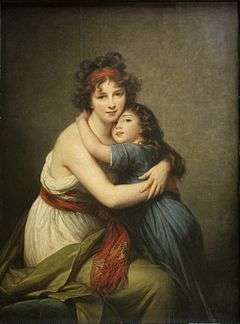 Self-Portrait with Her Daughter, 1789
Self-Portrait with Her Daughter, 1789
- Portraits painted in Italy
 Francesco di Borbone, 1790
Francesco di Borbone, 1790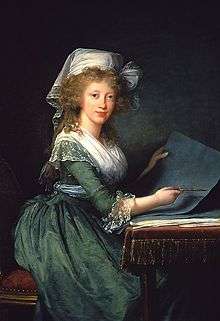 Luisa Maria Amelia di Borbone, 1790
Luisa Maria Amelia di Borbone, 1790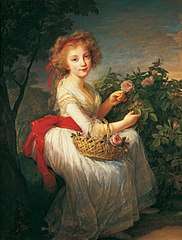 Maria Cristina di Borbone, 1790
Maria Cristina di Borbone, 1790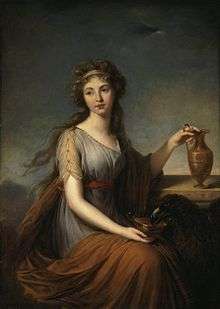 Anne Pitt as Hebe, 1792
Anne Pitt as Hebe, 1792 Emma Hamilton as a Bacchante, ca. 1792
Emma Hamilton as a Bacchante, ca. 1792
- Portraits painted in Austria
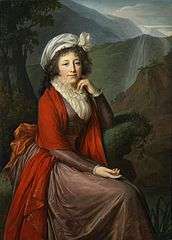 Portrait de la comtesse Maria Theresia Bucquoi, 1793
Portrait de la comtesse Maria Theresia Bucquoi, 1793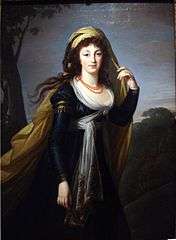 Theresa, Countess Kinsky, 1793
Theresa, Countess Kinsky, 1793_LeBrun.jpg) Princess Karoline of Liechtenstein, 1793
Princess Karoline of Liechtenstein, 1793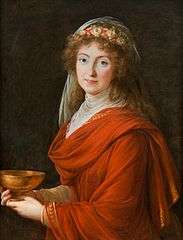 Countess Siemontkowsky-Bystry, 1793
Countess Siemontkowsky-Bystry, 1793
- Portraits painted in Russia
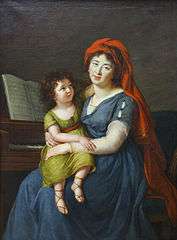 Princess Ekaterina Nikolaevna Menshikova, 1795
Princess Ekaterina Nikolaevna Menshikova, 1795
.jpg)
 Princess Ana Gruzinsky Galitzine, 1797
Princess Ana Gruzinsky Galitzine, 1797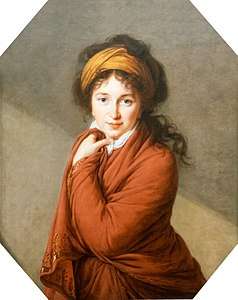 Varvara Golovina, ca. 1797–1800
Varvara Golovina, ca. 1797–1800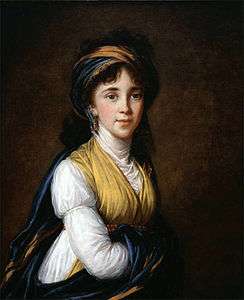 Anna Beloselskaya-Belozerskaya, 1798
Anna Beloselskaya-Belozerskaya, 1798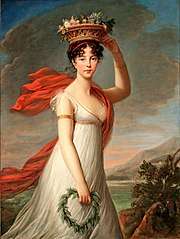 Julie Le Brun as Flora, 1799
Julie Le Brun as Flora, 1799
See also
References
- 1 2 3 4 5 6 Baillio, Joseph; Salmon, Xavier, eds. (2015). Élisabeth Louise Vigée Le Brun. Paris: Éditions de la Réunion des musées nationaux—Grand Palais.
- 1 2 Kleiner, Fred S., ed. (2015). Gardner's Art through the Ages: The Western Perspective. 2 (15th ed.). Boston: Cengage Learning. p. 656. ISBN 9781305645059.
- ↑ "National Museum of Women in the Arts". Retrieved 26 October 2016.
- ↑ Christiane, Weidemann; Larass, Petra; Klier, Melanie (2008). 50 Women Artists You Should Know. Munich: Prestel.
- 1 2 3 Goodden, Angelica (1997). The Sweetness of Life: A Biography of Elisabeth Louise Vigée Le Brun. London: André Deutsch Limited.
- 1 2 3 4 5 6 7 The Memoirs of Elisabeth Vigée-Le Brun. Translated by Siân Evans. London: Camden Press. 1989.
- 1 2 3 4 5 6 Nicholson, Kathleen. "Vigée Le Brun, Elisabeth-Louise". Grove Art Online. Oxford Art Online. Oxford University Press. Retrieved 21 November 2014.
- ↑ Langmuir, Erika (1997). The National Gallery Companion Guide (rev. ed.). London: National Gallery Publications Ltd. pp. 328–329.
- ↑ "Self-Portrait in a Straw Hat". National Gallery. Retrieved 10 March 2018.
- ↑ Duffy, Stephen; Hedley, Jo (2004). The Wallace Collection's Pictures: A Complete Catalogue. London: Unicorn Press and Lindsay Fine Art Ltd. pp. 460–462.
- ↑ Jones, Colin (2003). The Great Nation: France from Louis XIV to Napoleon. London: Penguin Books. p. 364. ISBN 9780140130935.
- ↑ Beauvoir, Simone de (2009). Extracts from The Second Sex. Translated by Constance Borde and Sheila Malovany-Chevallier. Vintage.
- 1 2 Larkin, T. Lawrence (2003). "'Je ne suis plus la Reine, je suis moi': Marie-Antoinette at the Salon of 1783". Aurora: The Journal of the History of Art. 4: 109–134.
- ↑ Baillio, Joseph (May 1981). "Le dossier d'une oeuvre d'actualité politique: Marie-Antoinette et ses enfants par Mme Vigée Le Brun (2e partie)". L'Oeil (310): 53–60, 90–91.
- ↑ Sheriff, Mary D. (2003). "The Cradle is Empty: Elisabeth Vigée-Lebrun, Marie-Antoinette, and the Problem of Invention". In Hyde, Melissa; Milam, Jennifer. Women, Art and the Politics of Identity in Eighteenth-Century Europe. Burlington, VT: Ashgate Publishing Company. pp. 164–187.
- 1 2 Fidière, Octave (1885). Les Femmes artistes à l'Académie royale de peinture et de sculpture. Paris: Charavay Frères.
- ↑ Auricchio, Laura (2009). Adélaïde Labille-Guiard: Artist in the Age of Revolution. Los Angeles: J. Paul Getty Museum.
- 1 2 3 4 5 6 Sheriff, Mary D. (1996). The Exceptional Woman: Elisabeth Vigée-Lebrun and the Cultural Politics of Art. Chicago: University of Chicago.
- 1 2 3 May, Gita (2005). Elisabeth Vigée Le Brun: The Odyssey of an Artist in an Age of Revolution. New Haven: Yale University Press.
- 1 2 3 4 5 6 7 8 Baillio, Joseph (1982). Elisabeth Louise Vigée Le Brun. Fort Worth: Kimbell Art Museum.
- 1 2 Baillio, Joseph, ed. (2005). The Arts of France from François Ier to Napoléon Ier. New York: Wildenstein. pp. 325–329.
- 1 2 Hottle, Andrew D. (2010). "More Than 'a preposterous neo-classic rehash': Élisabeth Vigée Le Brun's Sibyl and its Virgilian Connotations". Aurora: The Journal of the History of Art. 11: 120–146.
- 1 2 Baumstark, Reinhold (1981). Masterpieces from the Collection of the Princes of Liechtenstein. Translated by Robert Erich Wolfe. Zürich: Artemis Verlag. pp. 312–313.
- ↑ Nikolenko, Lada (1967). "The Russian Portraits of Madame Vigée-Lebrun". Gazette des Beaux-Arts. 70: 93–120.
- ↑ "Russian Francophiles of the Dix-huitième". Apollo (160): 420–451. June 1975.
- ↑ "Élisabeth Vigée Le Brun: Woman Artist in Revolutionary France". Metropolitan Museum of Art. Retrieved 10 March 2018.
- ↑ "Elisabeth Louise Vigée Le Brun (1755–1842)". National Gallery of Canada. Retrieved 10 March 2018.
- ↑ Genzlinger, Neil (11 April 2007). "How a Queen Lost Her Heart Before She Lost Her Head". New York Times.
External links
| Wikimedia Commons has media related to Elisabeth Vigée-Lebrun. |
- The Memoirs of Madame Vigée Lebrun at Project Gutenberg
- Artcyclopedia entry
- Neil Jeffares, Dictionary of Pastellists before 1800, Online Edition
- Art UK: Works of art by Vigée Le Brun in British Collections
- Gallery of works by Vigée Le Brun, articles, her memoirs, and biographical information
- Vigée Le Brun: Woman Artist in Revolutionary France at the Metropolitan Museum of Art
- Works by Élisabeth Vigée Le Brun at LibriVox (public domain audiobooks)

- Katherine Baetjer: "Vigée Le Brun: Woman Artist in Revolutionary France.", Modern Arts Notes Podcast